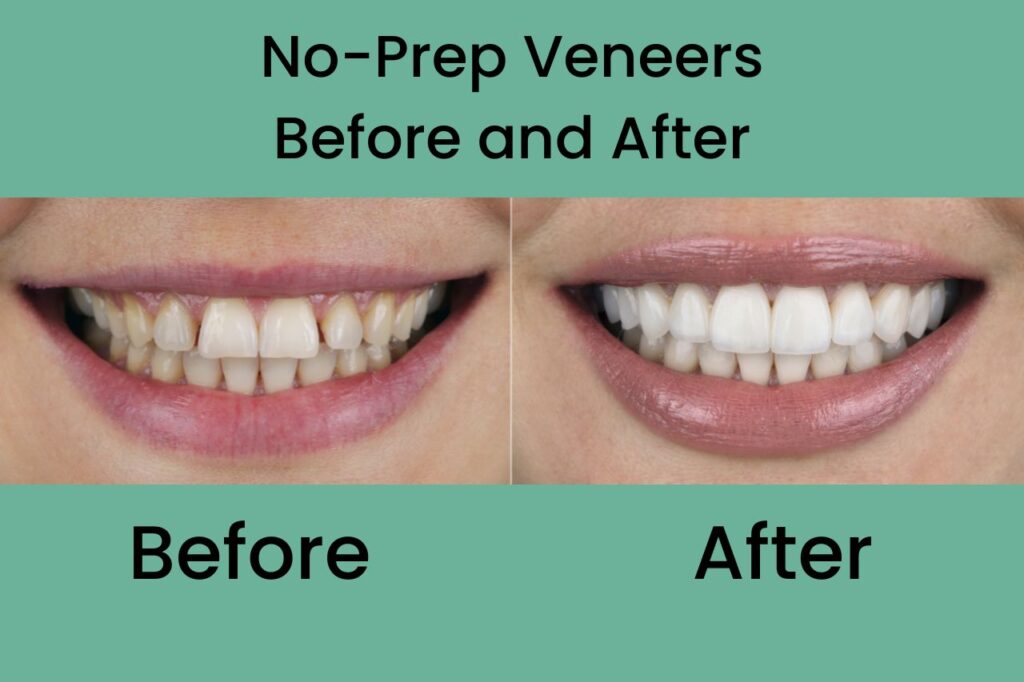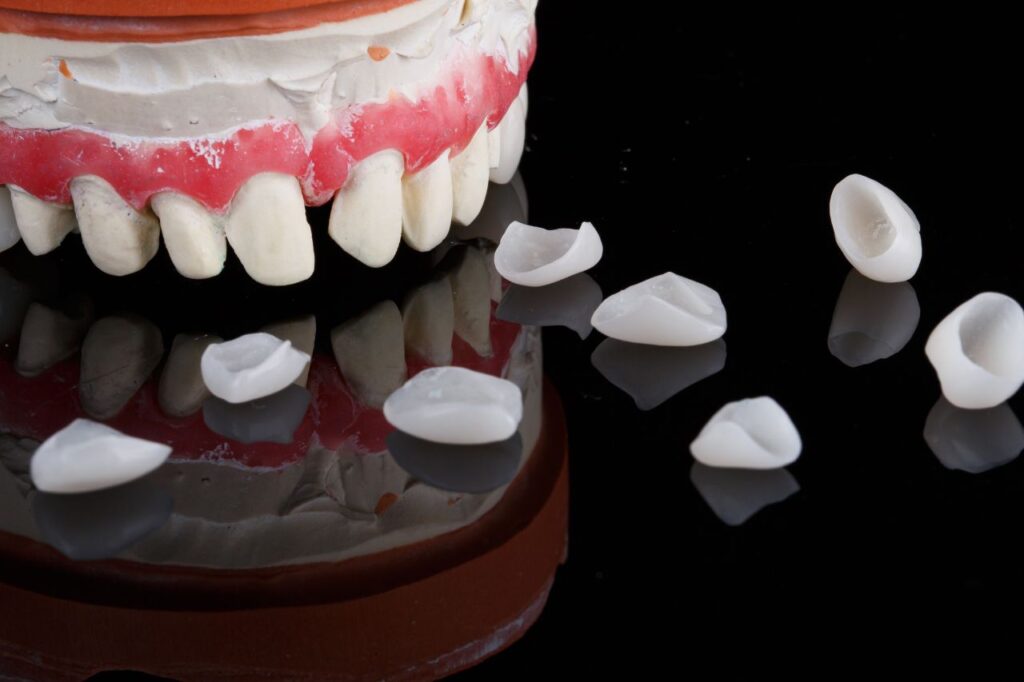Pros And Cons Of No-Prep Veneers: What You Should Know BEFORE You Decide
A smile is often seen as one of the most important aspects of a person’s appearance. Marilyn Monroe called her smile the best makeup a girl can wear. In fact, a survey found that nearly one-third of adults in the United States are unhappy with their smile, with 15% reporting they are ‘not at all or not very satisfied’. What’s more, 16% of respondents said their smile negatively affects their self-confidence.
Interestingly, the study also found that those who have regular dental check-ups reported higher levels of self-confidence. If you are unhappy with your smile, perhaps no-prep veneers can help restore your confidence. Read about the pros and cons of no-prep veneers.
In This Article:
- What Are No-Prep Veneers?
- The Advantage Of No-Prep Veneers
- Downsides Of Prepless Veneers
- The Cost Of Minimal Prep Veneers
- Different Types Of No-Prep Veneers
- The Procedure Of Getting No-Prep Veneers
- When Are No-Prep Veneers A Good Solution?
What Are No-Prep Veneers?
No-prep veneers, also known as minimal prep or prepless veneers, are a type of cosmetic dental treatment that involves applying a thin layer of porcelain or composite material to the front surface of a tooth. As their name suggests, no-prep veneers require little or no preparation of the natural tooth before placement, which sets them apart from traditional veneers.
Traditional veneers typically require the removal of a layer of enamel from the tooth’s surface to make room for the veneer. Often, teeth even have to be ground down, at least 0,5 mm. Some reshaping is usually part of the procedure. In contrast, no-prep veneers are much thinner and can be placed directly on the tooth without the need for significant alteration of the natural tooth structure.

No-prep veneers can be used to address a range of cosmetic dental issues, including discoloration, chips, cracks, and minor misalignments. They are also often used as a less invasive alternative to traditional veneers for patients who have relatively healthy teeth and gums but want to improve the appearance of their smile.
Also interesting: Dental Veneers vs. Implants: Which Treatment is Right for You?
The Advantage Of No-Prep Veneers
No-prep veneers come with several benefits over traditional veneers, making them an attractive option for many patients.
They are minimally invasive and require little to no removal of natural tooth structure, which is great news for those who are hesitant about undergoing more invasive procedures.
No-prep veneers have a relatively quick application time, meaning that patients can often achieve their desired results in just one or two appointments with their dentist. This is the ‘no-prep’ part. It’s especially appealing for those who have busy schedules and limited time for dental appointments (or those who have a minor fear of dentistry).
Another benefit of no-prep veneers is that they are not permanent. Unlike traditional veneers, which require permanent alteration of the natural tooth structure, no-prep veneers can be removed without causing damage to the underlying tooth. This can provide peace of mind for those who may be concerned about committing to a non-reversible dental treatment.
Real-life examples of patients who have had positive experiences with no-prep veneers are plentiful. Many people feel more confident after receiving no-prep veneers, thanks to their ability to improve the appearance of their teeth without the need for extensive dental work.
Downsides Of Prepless Veneers
While no-prep veneers come with several benefits, there are also some potential drawbacks to consider.
Not every patient is a candidate. While it can be a great option for patients with relatively healthy teeth and gums, those with more serious dental issues may require more extensive treatment, such as traditional veneers or crowns. Also, no-prep veneers add a little layer to your teeth. If you already have quite large teeth, they may feel bulky after. Likewise, the small (0,3 mm) layer of veneer may cause a slight gap at the gum line. This shows as a little bump. When you have a crooked tooth, the gap would be bigger. In that case, non-prep veneers are usually not recommended.
No-prep veneers may not be as durable as traditional veneers. Because they are thinner and require less preparation of the natural tooth structure, they may be more prone to cracking or chipping over time. While they can be repaired or replaced, this can add to the overall cost of treatment.
They may also not provide as dramatic of a transformation as traditional veneers. While no-prep veneers can certainly improve the appearance of teeth, they may not be able to address more significant issues, such as crooked or rotated teeth.
The procedure may not be covered by dental insurance. Because it is considered a cosmetic treatment rather than a medically necessary one, some insurance plans may not cover the cost of no-prep veneers.
The Cost Of Minimal Prep Veneers
The cost will depend on the condition of your teeth and your wishes. Generally speaking, prepless veneers will cost a bit more than traditional veneers. On average, good quality no-prep veneers cost between $1500 to $2500 per tooth. Traditional veneers usually range between $900 and $2500 per tooth.
However, despite costing slightly more, they on average last 5 to 7 years longer than traditional veneers.
Different Types Of No-Prep Veneers
No-prep veneers come in several different types, each with its unique properties and benefits. Here are a few popular types to consider:

Lumineers
These veneers are very thin and can provide a natural-looking result. The procedure for applying Lumineers is pain-free and can usually be completed in just a few hours.
DURAthin veneers
This brand of veneers is made of very thin, translucent layers of porcelain that are bonded directly to the teeth, with no need for any grinding or shaving beforehand. They are designed to be easily removed and keep your natural smile intact.
Vivaneers
Thin and strong, like Lumineers they are also 0.33mm thick. Designed to provide a natural-looking result.
At Mint Dental, we offer you our professional advice on which type suits best for your situation. Our expert dentist will discuss the options on your first consultation.
The Procedure Of Getting No-Prep Veneers
The procedure for placing no-prep veneers is typically less invasive than traditional veneers and can be completed in just a few appointments.
- The first step in getting no-prep veneers is to schedule a consultation with your dentist. During this visit, your dentist will evaluate your teeth, take x-rays and discuss your goals for your smile.
- Once your dentist has determined that no-prep veneers are right for you, they will create a custom design for your veneers. This starts with an impression or mold of your teeth, sometimes a scan will be made. These will be sent off to a lab, where they will make the veneer. We will choose the right shade together. This way, we can ensure the result will look natural.
- Sometimes, there is an additional appointment where we fit a prototype. This depends on the type of no-prep veneer you choose and your specific situation.
- Unlike traditional veneers, no-prep veneers usually don’t require any preparation of your natural teeth. We will check the fit of the veneers. When all is well, we will simply clean your teeth and prepare them for bonding by etching the enamel surface of your teeth.
- After this, we apply a special bonding agent to the surface of your teeth and then place the veneers on top of the bonding agent.
- The only thing that needs to be done is clean any leftover bonding agent. Sometimes we polish the veneers, but that’s not always necessary.
Overall, the procedure for placing no-prep veneers is minimally invasive and usually takes just a few hours to complete. Most patients experience little to no discomfort during the procedure and can resume normal activities (like eating and drinking) immediately afterward.
When Are No-Prep Veneers A Good Solution?
No-prep veneers are a great option for people who want to improve the appearance of their teeth without the need for extensive dental work. They’re especially ideal if you have a healthy tooth structure and are dealing with issues such as tooth discoloration or staining, slightly crooked or misaligned teeth, moderate spacing or sizing issues, or mildly chipped or broken teeth.
Alternatives to no-prep veneers
In most cases, if you’re interested in no-prep veneers, you probably want to improve your smile. There are a variety of alternative cosmetic dental procedures that can help improve the appearance of your smile. Some of them include:
- Traditional veneers. Unlike no-prep veneers, traditional veneers require preparation of the tooth structure before they can be applied: the teeth are often filed down. That means they are permanently altered. However, they can also provide a more dramatic transformation for people dealing with more significant cosmetic issues.
- Teeth whitening. For people dealing with tooth discoloration or staining, teeth whitening treatments can be a simple and effective solution.
- Orthodontic treatments. If you’re dealing with more significant spacing or alignment issues, orthodontic treatments such as braces or clear aligners may be more appropriate.
- Composite bonding. This procedure involves using a tooth-colored composite resin to reshape or repair teeth and can be a good option for people with minor chips, cracks, or gaps between teeth.
Ultimately, the best cosmetic dental procedure for you will depend on your individual needs and goals.
